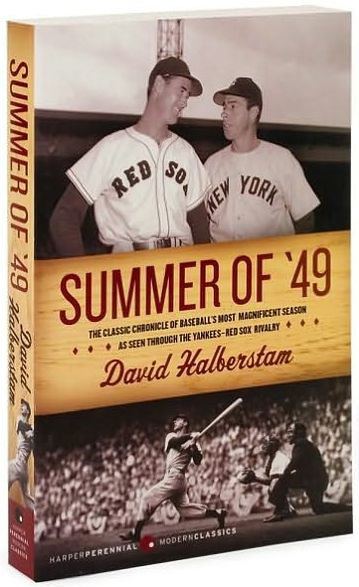The year was 1949, and a war-wearied nation turned from the battlefields to the ball fields in search of new heroes. It was a summer that marked the beginning of a sports rivalry unequaled in the annals of athletic competition. The awesome New York Yankees and the indomitable Boston Red Sox were fighting for supremacy of baseball's American League and an aging Joe DiMaggio and a brash, headstrong hitting phenomenon named Ted Williams led their respective teams in a classic pennant duel of almost mythic proportions—one that would be decided in an explosive head-to-head confrontation on the last day of the season...
With incredible skill, passion and insight, Pulitzer Prize-winning author David Halberstam returns us to that miraculous summer... and to a glorious time when the dreams of a now almost for gotten America rested on the crack of a bat.
The year was 1949, and a war-wearied nation turned from the battlefields to the ball fields in search of new heroes. It was a summer that marked the beginning of a sports rivalry unequaled in the annals of athletic competition. The awesome New York Yankees and the indomitable Boston Red Sox were fighting for supremacy of baseball's American League and an aging Joe DiMaggio and a brash, headstrong hitting phenomenon named Ted Williams led their respective teams in a classic pennant duel of almost mythic proportions—one that would be decided in an explosive head-to-head confrontation on the last day of the season...
With incredible skill, passion and insight, Pulitzer Prize-winning author David Halberstam returns us to that miraculous summer... and to a glorious time when the dreams of a now almost for gotten America rested on the crack of a bat.

Summer of '49
384
Summer of '49
384Paperback(Reissue)

Product Details
| ISBN-13: | 9780060884260 |
|---|---|
| Publisher: | HarperCollins |
| Publication date: | 05/09/2006 |
| Series: | P. S. Series |
| Edition description: | Reissue |
| Pages: | 384 |
| Sales rank: | 93,161 |
| Product dimensions: | 5.31(w) x 8.00(h) x 0.86(d) |
About the Author

Customer Reviews
Explore More Items
Hercule Poirot finds himself embroiled in a world of international intrigue and espionage as he investigates a series of mysteries involving the shadowy organization known as the Big Four. These
Mr. Shaitana is famous
"My very first grown-up book, I distinctly remember going to the library and my mom helping me pick out an Agatha Christie book. I tore through The Mysterious Affair at Styles. GILLIAN FLYNN, author
Michael Lewis, whose LIAR'S POKER foreshadowed events at
“With this book, Tim encourages readers to keep moving and stay
Take the practical steps you need to find your unique, God-given sense of mission and purpose in this motivating, interactive, biblically based companion study to Tim Tebow's Mission Possible.
In
Tim Tebow, one of America's best-known, iconic athletes shares the important lessons he's learned from the timeless wisdom of the Book of Proverbs in this timely book. Throughout his storied football
Agatha Christie demonstrates her unparalleled mastery with Three Blind Mice and Other Stories--a classic compendium of mystery and suspense, crime and detection, whose title novella served as the



